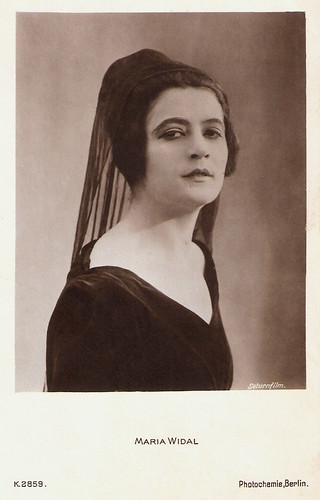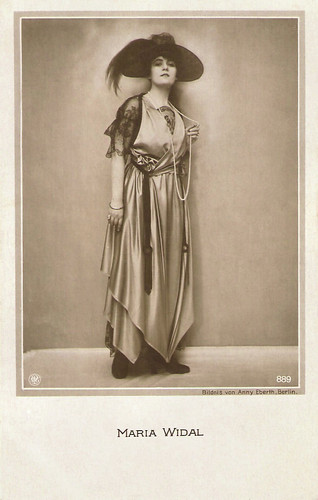Maria Widal started her career in the silent Danish cinema, credited as Luzzy Werren. In 1916, director Urban Gad built her up as a star for the German cinema and he directed nearly all her German films. She made her last film in 1920.

German postcard by Photochemie, Berlin, no. K. 2859. Photo: Saturnfilm.
According to Den Danske Film Database, Maria Widal was a German actress, but nor her birth place nor her birth date are known.
In 1914, she started her career as a film actress in Denmark, where she made 17 silent films. In Danmark she was known as Luzzy Werne or Luzzy Werren.
She made her film debut with a small role as an adventurer in Under Vampyrens Kløer/In the claws of the vampire (1914). She also appeared in the Danish comedy Man skal ikke skue Hunden paa Haarene (Sofus Wolder, 1914) for the Nordisk Film Kompagni.
For Nordisk, she also made the comedies Min Ven Levy/My Friend Levy (Holger Madsen, 1914), and Endelig alene/Finally alone (Holger Madsen, 1914), both with Carl Schenstrom, later part of the famous comedy duo Fy og Bi or Pat & Patachon.
The following years, she made with director Aage Brandt such dramas as Skyldig - ikke skyldig/Guilty - not guilty (Aage Brandt, 1915) and Karfunkeldronningen/Carbuncle Queen (Aage Brandt, 1916) for the Filmfabrikken Skandinavien.
For Nordisk, she appeared with Valdemar Psilander in Det stjaalne ansigt/The Solen Face (Holger Madsen, 1916).

German postcard by NPG, no. 889. Photo: Anny Eberth, Berlin.

German postcard by NPG, no. 890. Photo: Anny Eberth, Berlin.
In 1916, actress Maria Widal was built up by director Urban Gad as a new film star for the German cinema.
She made her German film debut for Saturn-Film in the German-Danish coproduction Der rote Streifen/The red stripe (Urban Gad, 1916) with Ernst Hofmann.
In the next years followed many other productions for Saturn-Film, including Die verschlossene Tür/The locked door (Urban Gad, 1917) with Albert Paul, Vera Panina (Urban Gad, 1918), and Der Schmuck des Rajah/The jewellery of the Rajah (Urban Gad, 1918).
After World War I, Widal starred in Irenes Fehltritt/Irene's misstep (Fritz Bernhardt, 1919) and Im Rausche der Sinne/In the poisoning of the senses (Ernst Sachs, 1919).
In 1920, Maria Widal already made her last films, Das Lied der Tränen/The Song of Tears (Fritz Bernhardt, 1920) and Graf Festenberg/Count Festenberg (1922) directed by Friedrich Zelnik and starring Charles Willy Kayser.
We could not find more information about Maria Widal. Any suggestions?

German postcard by Rotophot in the Film Sterne series, no. 112/3. Photo: Nicola Perscheid, Berlin.

German postcard by Photochemie, no. K.2511. Photo: Saturn-Film. Maria Widal in Das sterbende Modell/The dying model (Urban Gad, 1918).
Sources: Thomas Staedeli (Cyranos), Den danske film database (Danish) and IMDb.

German postcard by Photochemie, Berlin, no. K. 2859. Photo: Saturnfilm.
Luzzy Werren
According to Den Danske Film Database, Maria Widal was a German actress, but nor her birth place nor her birth date are known.
In 1914, she started her career as a film actress in Denmark, where she made 17 silent films. In Danmark she was known as Luzzy Werne or Luzzy Werren.
She made her film debut with a small role as an adventurer in Under Vampyrens Kløer/In the claws of the vampire (1914). She also appeared in the Danish comedy Man skal ikke skue Hunden paa Haarene (Sofus Wolder, 1914) for the Nordisk Film Kompagni.
For Nordisk, she also made the comedies Min Ven Levy/My Friend Levy (Holger Madsen, 1914), and Endelig alene/Finally alone (Holger Madsen, 1914), both with Carl Schenstrom, later part of the famous comedy duo Fy og Bi or Pat & Patachon.
The following years, she made with director Aage Brandt such dramas as Skyldig - ikke skyldig/Guilty - not guilty (Aage Brandt, 1915) and Karfunkeldronningen/Carbuncle Queen (Aage Brandt, 1916) for the Filmfabrikken Skandinavien.
For Nordisk, she appeared with Valdemar Psilander in Det stjaalne ansigt/The Solen Face (Holger Madsen, 1916).

German postcard by NPG, no. 889. Photo: Anny Eberth, Berlin.

German postcard by NPG, no. 890. Photo: Anny Eberth, Berlin.
Urban Gad
In 1916, actress Maria Widal was built up by director Urban Gad as a new film star for the German cinema.
She made her German film debut for Saturn-Film in the German-Danish coproduction Der rote Streifen/The red stripe (Urban Gad, 1916) with Ernst Hofmann.
In the next years followed many other productions for Saturn-Film, including Die verschlossene Tür/The locked door (Urban Gad, 1917) with Albert Paul, Vera Panina (Urban Gad, 1918), and Der Schmuck des Rajah/The jewellery of the Rajah (Urban Gad, 1918).
After World War I, Widal starred in Irenes Fehltritt/Irene's misstep (Fritz Bernhardt, 1919) and Im Rausche der Sinne/In the poisoning of the senses (Ernst Sachs, 1919).
In 1920, Maria Widal already made her last films, Das Lied der Tränen/The Song of Tears (Fritz Bernhardt, 1920) and Graf Festenberg/Count Festenberg (1922) directed by Friedrich Zelnik and starring Charles Willy Kayser.
We could not find more information about Maria Widal. Any suggestions?

German postcard by Rotophot in the Film Sterne series, no. 112/3. Photo: Nicola Perscheid, Berlin.

German postcard by Photochemie, no. K.2511. Photo: Saturn-Film. Maria Widal in Das sterbende Modell/The dying model (Urban Gad, 1918).
Sources: Thomas Staedeli (Cyranos), Den danske film database (Danish) and IMDb.
No comments:
Post a Comment